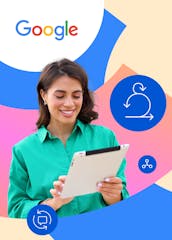What Is Assistive Technology?
Discover how assistive technology enhances the capabilities of people with disabilities, improving their independence, quality of life, and overall well-being.
![[Featured image] A UX designer is researching on a desktop the types of assistive technology she'll need to incorporate into a product.](https://d3njjcbhbojbot.cloudfront.net/api/utilities/v1/imageproxy/https://images.ctfassets.net/wp1lcwdav1p1/5BUhg6fKAuJMau6dqr4ZlN/2174d8da7c61c4f9fee275dd60330bed/vDDMNM0X.jpeg?w=1500&h=680&q=60&fit=fill&f=faces&fm=jpg&fl=progressive&auto=format%2Ccompress&dpr=1&w=1000)
Assistive technology is any hardware, software, or system that might help improve the capabilities of someone with disabilities. Assistive technology can be low-tech, high-tech, or no-tech solutions ranging from simple communication boards to complex prosthetics or computer programs.
Because user experience (UX) design focuses on making user-friendly products, it often involves creating and perfecting assistive technology and making products more accessible. Implementing assistive technology increases the number of people who can use it.
Who needs assistive technology?
Assistive technology benefits people with physical disabilities, such as individuals with mobility problems, visual impairment, speech impairment, and hearing impairment. People with mental disabilities, such as cognitive and developmental delays or learning disorders, can also benefit from assistive technology. Older people or people of any age who have functional decline, as well as people with conditions like autism, dementia, or stroke, can benefit as well.
What are some examples of assistive technology?
Assistive technology can range from a wheelchair to help someone with mobility issues to software that reads out loud for people with impaired vision. Some common examples include:
Screen readers and magnifiers: Screen readers and magnifiers help people with visual impairments by increasing the size of digital text or by reading digital text out loud.
Ergonomic keyboard: Ergonomic keyboards can help people with various physical ailments, but these devices can also help prevent physical problems from arising, making them a prime example of preventative technology.
Switch devices: Switch devices help people who can’t move or change positions easily perform multiple tasks in one place.
Braille keyboards: Braille keyboards allow people with visual impairments to communicate via writing.
Portable closed caption systems: People with hearing impairments can use mobile closed caption systems to participate in everyday activities.
Speech output software: Speech output software allows people who cannot communicate verbally to talk to those around them.
What are some benefits of creating more assistive technology?
The main benefit of creating more assistive technology is increasing access for a greater number of people, but that's just the beginning. For example, an older person with access to assistive technology may remain independent for a longer time. Certain types of assistive technology may help prevent the advancement of conditions or diseases. Still, this technology may help increase employment or education access for people with disabilities.
Get started with UX design and Google.
Assistive technology encompasses a wide range of tools and systems designed to enhance the capabilities of individuals with disabilities, from simple communication boards to advanced prosthetics. It significantly benefits people with various physical and mental disabilities, providing greater independence and access to education and employment opportunities.
A career in UX design offers opportunities to create new assistive technology. Get started on a path to this career by exploring courses on Coursera, including the Google UX Design Professional Certificate. You'll learn the fundamentals of UX design, sharpen your skill set, and create a professional portfolio. Upon completion, you’ll have exclusive access to a job platform with over 150 employees hiring for entry-level UX roles and other resources supporting your job search.

professional certificate
Google UX Design
Get on the fast track to a career in UX design. In this certificate program, you’ll learn in-demand skills, and get AI training from Google experts. Learn at your own pace, no degree or experience required.
4.8
(81,519 ratings)
1,151,292 already enrolled
Beginner level
Average time: 6 month(s)
Learn at your own pace
Skills you'll build:
User Experience (UX), Prototype, Wireframe, User Experience Design (UXD), UX Research, mockup, Figma, Usability Testing, UX design jobs
Keep reading
- 7 min read · November 29, 2023
- September 4, 2024
- November 29, 2023
- 11 min read · November 29, 2023
- August 20, 2024
- November 29, 2023

Coursera Staff
Editorial Team
Coursera’s editorial team is comprised of highly experienced professional editors, writers, and fact...
This content has been made available for informational purposes only. Learners are advised to conduct additional research to ensure that courses and other credentials pursued meet their personal, professional, and financial goals.
Build Agile skills to stay organized and complete projects faster.

Build job-ready skills with access to 10,000+ courses from top universities and companies.
